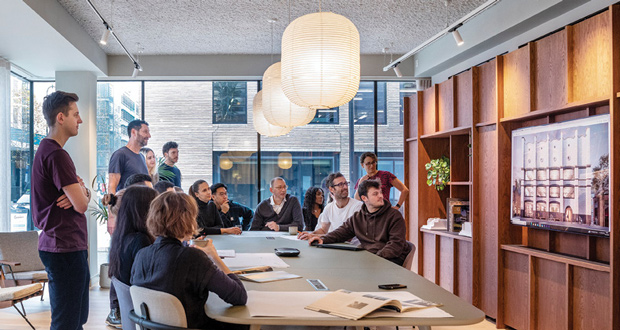 Excessive office noise is driving stress levels in workplaces. Ben Hancock, Managing Director of Oscar Acoustics explains why facilities managers must prioritise acoustic comfort to address occupant wellbeing
Excessive office noise is driving stress levels in workplaces. Ben Hancock, Managing Director of Oscar Acoustics explains why facilities managers must prioritise acoustic comfort to address occupant wellbeing
Despite the recent rise in return-to-office mandates, recent research conducted by Oscar Acoustics which is published in the report: ‘Shaping Future-Ready Workspaces for the Great Return to the Office’, shows that one-in-three UK office employees now work from home specifically to escape office noise. This is not for a work-life balance but to escape the acoustic chaos of poorly designed workspaces.
The report revealed that:
- Four in 10 (41 per cent) resort to headphones.
- 36 per cent work from home to escape office noise, and 30 per cent start earlier or finish later to enjoy quieter periods.
- Some take stronger measures, from leaving passive-aggressive notes and moving desks (26 per cent).
- Others resort to more extreme responses like making formal complaints (19 per cent) and snapping at colleagues (19 per cent).
As a result of excess noise, almost half of office workers struggle to concentrate (47 per cent), more than a third feel irritated (36 per cent) and 30 per cent report experiencing high stress levels.
In an earlier report, published in 2023, we found that poor acoustics negatively impact 81 per cent of employees, yet acoustic considerations were continually sidelined in most office planning processes. Unfortunately, many employers are still overlooking acoustic design; a costly mistake that’s alienating employees and crushing productivity. When your workspace is failing to attract talent, it’s time to recognise that acoustic design isn’t a luxury; it’s an essential element of business infrastructure, vital for workplace performance and employee retention.
THE HIDDEN COST OF ACOUSTIC NEGLECT
The financial implications of poor acoustics extend far beyond the initial budget savings from cutting sound treatments. Lost productivity, increased stress-related absences and talent attrition create costs that dwarf any upfront investment in proper acoustic planning.
Consider the rise of “headphone isolation bubbles” in modern offices. While employees may appear focused, this noise self-defence mechanism actually stifles the collaboration and spontaneous interaction that organisations desperately need. We’re creating workspaces that force people to disconnect in order to concentrate, a fundamental contradiction of modern office design principles.
The retention implications are particularly acute for younger workers. Two-thirds of employees aged 25-34 would consider leaving their role if forced back into poorly designed offices. For facilities managers tasked with supporting successful return-to-office policies, acoustic comfort isn’t optional; it’s a strategic imperative.
DESIGNING ACOUSTIC COMFORT: PRACTICAL STRATEGIES FOR FACILITIES MANAGERS
Effective acoustic design doesn’t require wholesale office reconstruction. Three key strategies can transform workplace sound management:
- Acoustic zoning creates distinct areas tailored for different work modes. Quiet zones support focused work; collaborative spaces accommodate team activities and transition areas provide acoustic buffers between different activity levels. This approach recognises that modern work requires diverse acoustic environments within a single space.
- Strategic material choices prioritise sound-absorbing solutions that integrate seamlessly with existing design schemes, such as acoustic sprays. The key is in selecting materials based on their acoustic effectiveness and fire ratings.
- Activity-based planning contains noisy activities within dedicated, acoustically isolated spaces. Phone calls, brainstorming sessions, and video conferences belong in designated meeting rooms or phone booths designed specifically for sound containment. This prevents acoustic spillover that disrupts areas for focused work.
THE BUSINESS CASE FOR ACOUSTIC INVESTMENT
Forward-thinking facilities managers are recognising acoustic design as a strategic investment rather than a cost centre. BREEAM certified buildings, which include acoustic performance criteria, can command rental premiums of up to 12 per cent according to a JLL report, compared to conventional spaces. This rate boost reflects market recognition that acoustic comfort directly impacts occupant satisfaction and productivity.
The return on investment extends beyond property values. Organisations with acoustically optimised workspaces report improved employee wellbeing, reduced stress-related absences, and enhanced collaboration effectiveness. These outcomes translate directly to bottom-line performance improvements that justify acoustic investments many times over.
MOVING FROM AWARENESS TO ACTION
The disconnect between acoustic awareness and implementation often stems from treating sound management as a post-occupancy problem rather than a primary design consideration. Successful acoustic design requires “acoustic-first” thinking; integrating sound management from the earliest planning stages, rather than attempting retrofits after problems emerge.
This shift in approach requires facilities managers to champion acoustic considerations during design discussions, ensuring that sound management receives equal priority with lighting, HVAC, and other environmental systems. The goal isn’t perfect silence; it’s about creating acoustic environments that support the diverse activities and interactions your organisation needs to thrive.
As we navigate the future of work, we need to create workspaces that genuinely support human performance and wellbeing. Acoustic design represents one of the most impactful, and often overlooked, tools in this mission. Acoustic comfort needs to come out from the backseat and be seen as a key indicator of future direction.





